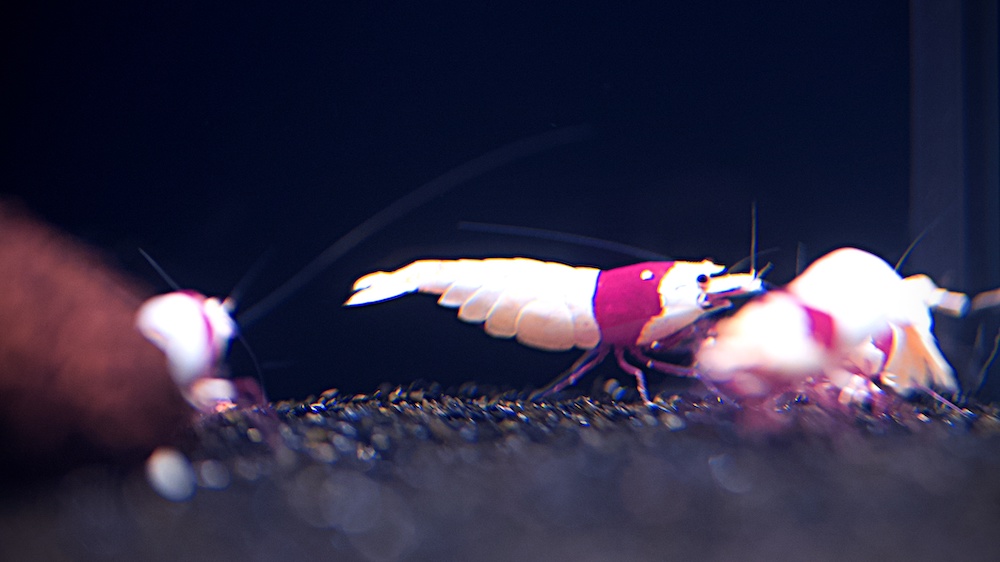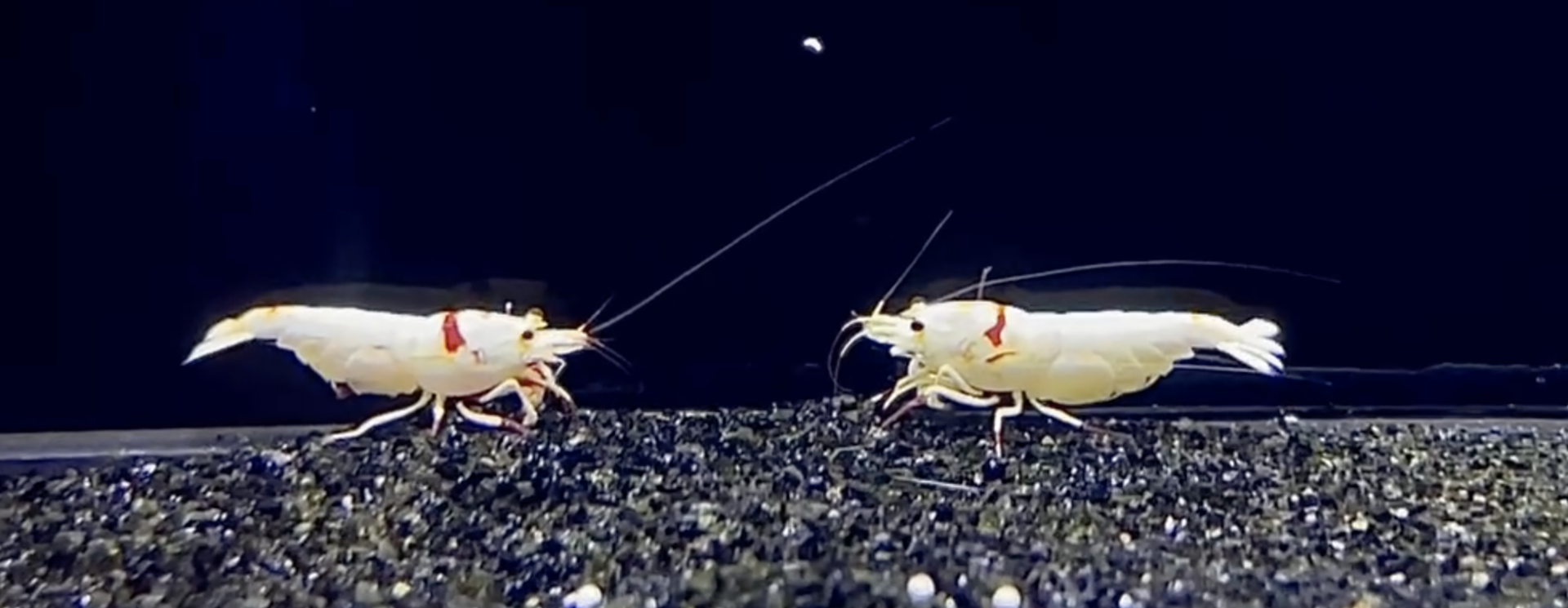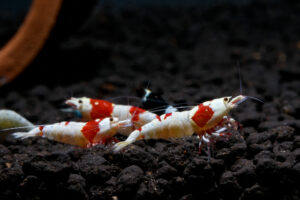Introduction to Crystal Red Shrimp
Yet even at modest entry grades, a well-bred CRS colony can be the vibrant centerpiece to an aquarium setup. Their relatively small size around 1 inch and peaceful nature make them suitable for most home aquariums (without predators). With the right water conditions, they will readily breed and display their impressive colors.
History of Crystal Red Shrimp
Wild Bee Shrimp were first discovered in Taiwan in the 1980s. Through selective breeding in the 1990s, the contrasting bright red and white coloration became more pronounced and stable. In Japan, breeders further refined the color patterns into specific “grades” like Hinomaru and Mosura Crown. Two main grading systems – the German K0-14 scale and the International C-SSS+ system – were developed to categorize the different aesthetic varieties from lower solid red to higher opaque white coverage.
As grading systems and valuation expanded, the shrimp gained immense popularity worldwide among hobbyists. Now, high-grade CRS specimens can command prices in the hundreds of dollars from enthusiasts devoted to pursuing “perfect” shrimp through breeding programs. But the shrimp appeal to all levels due to their unique looks and relatively easy care requirements.
Crystal Red Shrimp Care and Ideal Water Parameters
While grading and aesthetics are highly prized aspects of keeping Crystal Red Shrimp, providing proper care is essential for keeping them healthy and colored up. Maintaining suitable water parameters is key.
Water Parameters CRS are fairly sensitive shrimp that require stable water conditions. The ideal water parameters are:
TDS 100-120
pH 5.4-6.2
GH of 4-5
KH 0-1
Temperature 60-72 F
They prefer soft, slightly acidic water with a neutral to moderately low carbonate hardness. PH swings and high KH/GH levels can cause problems.
A few tips for setting up a successful CRS tank:
- Use a ph buffering substrate like aqua soil
- Add driftwood, leaf litter (Indian almond leaves), and botanicals to help acidify and introduce tannins into the water.
- Heavily plant the tank or add moss to provide grazing areas
- Avoid excessive flow
- Perform small (10-20%) weekly water changes using remineralized RO/DI or very soft tap water.
- Drip acclimate new water to avoid parameter swings during water changes.
- Provide ample hiding spots and caves to reduce stress.
- Maintain a peaceful tank community without aggressive tankmates.
- Feed a varied, high-quality diet including:
- Shrimp pellets/powders
- Blanched vegetables
- Algae/biofilm (leave lights on 8-10 hours/day to grow algae)
For a step by step guide on keeping a successful colony, click here
Understanding CRS Grading
The vibrant coloration and patterning of Crystal Red Shrimp is a major part of their appeal in the aquarium hobby. However, the numerous potential variations in shades, opacity, and distribution of red and white colors can make evaluating individual shrimp quite complex. That’s why standardized grading systems have become so important.
But before diving into the grading criteria, many newcomers often wonder about the basics of these fascinating creatures, such as what is a tibee (tb). Understanding the fundamentals can help clarify what makes some CRS specimens more desirable than others and why certain traits are prioritized in grading systems.
Grading systems provide a way to consistently assess and categorize the aesthetic qualities of Crystal Red Shrimp. This allows breeders and keepers to understand what caliber of shrimp they have and set goals for selective breeding towards higher grades over successive generations. The different grade levels also help determine the relative rarity and value of shrimp specimens. Higher graded shrimp with more vivid white coverage and distinct patterns can command premium prices from serious hobbyists.
Having a unified grading nomenclature makes it easier to buy, sell, trade, and discuss CRS within the community using a shared point of reference for quality.
The Two Main Grading Methods
German K0-14 Scale
Developed by the Logemann brothers in Germany, this scale grades shrimp from K0 (lowest) to K14 (highest) based primarily on the ratio and distribution of white coverage on the body. K0 represents shrimp with very little white, while a K14 specimens would be almost entirely white.
International C-SSS+ System
The international C-SSS+ system uses letter grades from C (lowest) through to SSS+ (highest) to assess CRS quality. C grade denotes shrimp with mostly red/black coloration, while SSS+ specimens exhibit superior solid white coverage with minimal red/black patterning remaining.
While the German and international methods use different labeling schemes, the core principle is the same – grading shrimp from low to high based on the increasing presence and intensity of white coloration versus red/black.
Both systems also consider the clarity and opacity of the white patches as a key data point, with more solid and evenly-colored white areas being most desirable.
Color Grading
One of the main aspects evaluated in grading Crystal Red Shrimp is the intensity, opacity, and solidity of their coloration. This color grading specifically assesses the vibrancy and evenness of the red and white pigments.
The goal of color grading is to identify shrimp that display rich, uniform colors without any transparency or patchiness. Shrimp with colors that appear washed out, blotchy, or where you can see the internal organs/structure are downgraded.
For the vivid white sections, breeders look for an opaque, solid coloration throughout the entire area without any transparent windows or streaks. The whiter and more evenly covered, the higher the color grade.
On the red portions, the ideal is an intense, solid red hue across the full segment. Colors that appear pale, semi-transparent, or mottled reduce the overall grade.
C Grade (K0): Mostly red/black coloration with minimal white. Both colors appear pale and semi-transparent.
B Grade (K2): Faint white stripes but mostly red/black body. Colors lack intensity and evenness.
A Grade (K4): Roughly even amounts of white and red/black. White has decent opacity but may have some transparency. Red appears blotchy.
S Grade (K6): White is the primary color with distinct opaque coverage. Red areas are solid with good intensity. Some patchiness may exist between colors.
SS Grade (K6-K8): Very intense, evenly spread opaque white. Solid vivid red/black remains on segments. Non-transparent leg coloration.
SS+ Grade (K8-K10): Solid white dominates with even less transparency than SS grade. Clean colors. Solid leg coloration.
SSS Grade (K10-K12): Virtually no transparent spots on the shell – shrimp is an opaque pure white with minimal red/black patterns. Leg coloration is equally as clean and thick.
SSS+ Grade (K14):
Attaining the higher SSS-level grades requires shrimp to display exceptional opacity and distinct, evenly-separated colors across the entirety of their body sections. This level of color quality is what serious breeders strive for in their selective breeding efforts.
Pattern Grading
SSS-Grade (K14) Crystal Red Shrimp
Key Patterns in SSS-Grade:
-
Smiley Faces (K14):
- Description: These shrimp have a solid white color with a red marking on the head and a dash right behind it, creating a smiley face image when viewed from above.
- Notable Achievement: Won 1st place in North American International Shrimp Contest (NAISC) 2024.
-
Mosura Crown:
- Description: A semicircular crown-like marking on the top or side of the head, with two large rhombuses connected by a smaller central rhombus.
- View: Visible from the top.
-
Mosura Flower:
- Description: Features white spots on the red sides of the carapace, resembling flowers.
- View: Visible from the side.
-
Mosura Heart:
- Description: Displays a heart-shaped dash on the top of the red carapace.
- View: Visible from the side.
SS-Grade (K8 – K10) Crystal Red Shrimp
Key Patterns in SS-Grade:
-
Hinomaru (Rising Sun) (K8):
- Description: Red carapace with white horizontal bands and a reduced red band on the abdomen, forming a spot or circle.
- View: Visible from the top.
-
Double Hinomaru (K10):
- Description: Similar to Hinomaru but with an additional small dot on the tail.
- View: Visible from the top.
-
Stop or No Entry Sign (K8):
- Description: Red carapace with white horizontal bands and a red spot with a small white line inside on the abdomen. Similar to a no-entry street sign.
- View: Visible from the top.
-
Half Moon (K10):
- Description: Red carapace with white bands and a semi-circle red spot on the abdomen.
- View: Visible from the top.
-
Little Lips (K10):
- Description: Red carapace with white bands and a red spot divided by a white line.
- View: Visible from the top.
-
Japanese Flag:
- Description: Red spot in a round shape on a white abdomen, resembling the Japanese flag.
- View: Visible from the top.
-
Large Maro:
- Description: Two white dots on the red carapace behind the head, sometimes called “Godzilla” due to the eye-like appearance.
- View: Visible from the top.
S-Grade (K6) Crystal Red Shrimp
Key Patterns in S-Grade:
-
Tiger-Toothed:
- Description: Red carapace with white bands and a red band on the abdomen with two downward-pointing tips.
- View: Visible from the side.
-
V-Banded:
- Description: Red carapace with white bands and a V-shaped red band on the abdomen.
- View: Visible from the side.
-
Small Maro:
- Description: Two small white dots on the red carapace behind the head.
- View: Visible from the side.
-
Four White Bands:
- Description: The body has four white bands and three red bands.
- View: Visible from the side.
-
Three White Bands:
- Description: The body has three white bands, two red bands, and an entirely red or semi-red tail.
- View: Visible from the side.
Factors Affecting Grading
Importance of White Coverage and Intensity
How Transparent Areas Lower the Grade
Effects of Stress and Age on White Coloration
Color vs Pattern – Which is More Important?
- High-Grade Color vs. Top Pattern: A shrimp with a high color grade, such as one with deep, opaque white and rich red, can be more valuable than one with a perfect pattern but less intense colors. For instance, an SS-grade shrimp with stunning color will generally fetch a higher price than an SSS-grade shrimp with a more intricate pattern but less vibrant color.
- Market Value: At auctions, shrimp with superior color quality often attract higher bids. Even if a shrimp has a well-defined pattern, if the colors are not vivid and solid, its market value decreases. Collectors and breeders are willing to pay more for shrimp with exceptional color, as it signifies premium genetics and overall quality.
How to Inspect and Grade CRS
Tips for Properly Evaluating and Grading CRS Specimens
- Use Proper Lighting: Ensure you have adequate lighting to clearly see the colors and patterns. Natural daylight or high-quality aquarium lights are ideal for revealing the true colors of the shrimp.
- Examine from Multiple Angles: View the shrimp from different angles to assess the coverage and intensity of the colors, as well as the pattern consistency. Top, side, and bottom views are all important.
- Focus on Color Intensity and Coverage: Pay close attention to the brightness and extent of the white and red coloration. Higher grades have more vibrant and extensive color patches.
- Look for Transparency: Check for any transparent areas in the coloration, as these lower the shrimp’s grade. Transparency can indicate stress, poor health, or inferior genetics.
- Assess the Pattern: Identify and categorize the patterns according to established grading criteria. Consistent and well-defined patterns are preferred, but remember that color often outweighs pattern in importance.
- Consider the Shrimp’s Health and Behavior: Healthy, active shrimp with clear, solid colors are more likely to be of higher quality. Lethargic or discolored shrimp may not grade as well.











